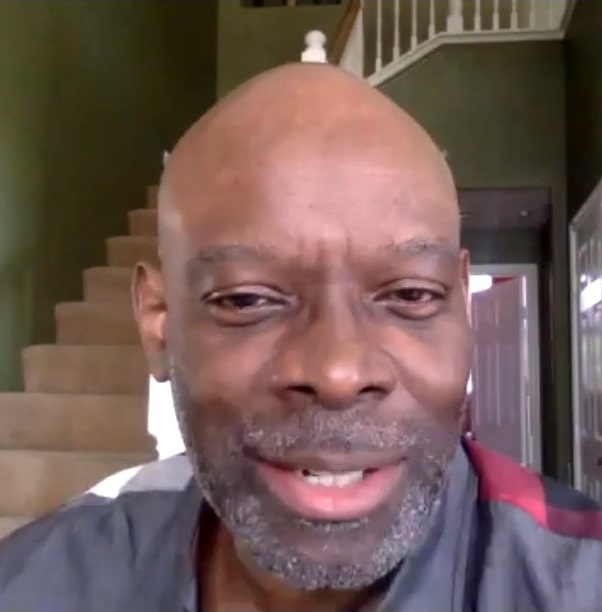Ron McCurdy, a professor of music at the University of Southern California, gave a presentation Tuesday on the Harlem Renaissance of the 1920s and 1930s. His appearance was the first in a series of four planned for the upper school’s spring semester. McCurdy, who previously served as a professor of music and chair of the Afro-American Studies Department at the University of Minnesota, is also the creator of the Langston Hughes Project, a live multimedia performance of Langston Hughes’ “Ask Your Mama: 12 Moods for Jazz,” which will be performed during McCurdy’s fourth appearance in April.
The presentation began with a brief history of the arrival of the first Africans on the American continent in the 17th century, their enslavement by European settlers (at the persuasion of rich European landowners), the Emancipation Proclamation (which McCurdy said was an act of “economic and political expediency”) and the 13th Amendment, which formally abolished slavery but contained a massive loophole: that people guilty of criminal behavior could be placed back into bondage.
“So we know that with the 13th Amendment being enacted, that almost any aspect of African-American life was somehow criminalized,” McCurdy said. One of the most flagrant abuses of the loophole involved the crime of vagrancy, in which a person was unable to produce papers proving they were employed. This criminalization of Black life, McCurdy said, continues today. “It is no accident … that even though African-Americans make up less than 30 percent of the population, we represent more than 50 percent of the population in prison,” he noted.
During the migration of Black Americans from the South to the North and Midwest, “an amalgamation of doctors, lawyers, teachers, dentists, gangsters … you name it,” arrived in Harlem, McCurdy said. This also included a great number of artists and intellectuals, resulting in what has become known as the Harlem Renaissance. “The Harlem Renaissance was probably one of the first times in our country where white America began to take notice of African-American culture,” said McCurdy. Before then, Black Americans were judged only by the amount of labor they performed.
Artists from many disciplines – including music, poetry, painting and literature – created works that chronicled Black life in the 1920s. McCurdy covered several of the key figures during this period, including Hughes, whose work delved into the contradiction of the idea of America as “land of the free.”
Harlem also had its own successful baseball and basketball teams. The New York Renaissance basketball team (often shortened to Rens), was based in Harlem and would play exhibition games against the Boston Celtics, who they frequently defeated. The Rens were paid in checks, which would often bounce. The two teams befriended one another, and the Celtics later demanded that the Rens be paid in cash.
Black musicians in the 1920s, many trained at top American musical schools, had difficulty finding opportunities in America and frequently performed in Europe. These included singer Marian Anderson, who toured successfully in Europe before returning to America. After being denied the opportunity to sing at Washington D.C.’s Constitution Hall by the Daughters of the American Revolution, she gave a now-famous concert at the Lincoln Memorial. Singer and actor Paul Robeson also became popular for his theater performances, particularly of the song “Ol’ Man River,” which he repurposed later in his life as an anthem against oppression. In the 1940s he was blacklisted for his sympathies for the Soviet Union and stances against American imperialism and could no longer travel abroad to perform.
The Cotton Club began operation in Harlem in 1923, employing Black entertainers whose performances at the whites-only venue helped launch their careers. Due to the popularity of minstrelsy and later vaudeville in the early 20th century, African-American performers “were expected to comport themselves in a very subservient way.” McCurdy recalled a conversation he had with trumpeter Wynton Marsalis, who held little respect for Louis Armstrong as a boy “until he understood the history. And that way of comporting yourself was a defense mechanism. It was a survival technique,” McCurdy said. “Because if you came across as an African-American man with any degree of arrogance or too much confidence, that could get you killed.”
The growing popularity of jazz brought with it new dances such as the Lindy Hop and the Big Apple. As an art, dance began “moving away from the Victorian style of living, where everything was pristine and carefully done,” McCurdy said. “Now many of the Black dances … these were all dances that found their genesis in the Black community.” This style became popular with white youths, who were “having themselves a ball, much to the chagrin of their parents,” McCurdy remarked.
McCurdy’s next appearance will take place in late February, in which he will examine jazz performance practices and how they are similar to leadership, using examples by Duke Ellington, Miles Davis and Benny Goodman.
